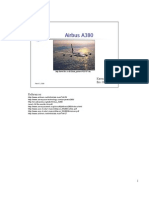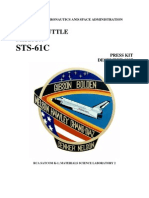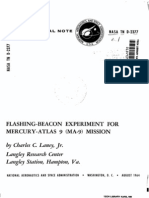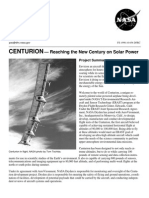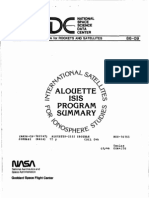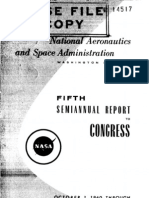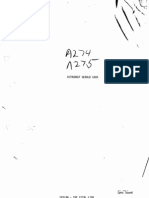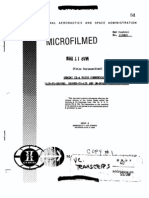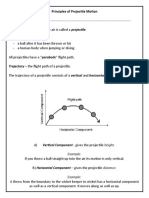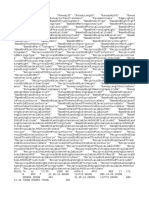0 ratings0% found this document useful (0 votes)
174 viewsNASA Facts Reinforced Carbon-Carbon (RCC) Panels 2004
NASA Facts Reinforced Carbon-Carbon (RCC) Panels 2004
Uploaded by
Bob AndrepontThe document discusses Reinforced Carbon-Carbon (RCC) panels that are used on the Space Shuttle orbiter during re-entry to protect it from high surface temperatures of up to 3,000 degrees Fahrenheit. The RCC panels are located on the orbiter's wing leading edges, nose cap, and other areas. They are made of carbon composite material and are about 0.25 to 0.5 inches thick. Prior to each mission, the RCC panels undergo inspections including visual, tactile, thermography, and ultrasound tests to check for damage or defects.
Copyright:
Attribution Non-Commercial (BY-NC)
Available Formats
Download as PDF, TXT or read online from Scribd
NASA Facts Reinforced Carbon-Carbon (RCC) Panels 2004
NASA Facts Reinforced Carbon-Carbon (RCC) Panels 2004
Uploaded by
Bob Andrepont0 ratings0% found this document useful (0 votes)
174 views2 pagesThe document discusses Reinforced Carbon-Carbon (RCC) panels that are used on the Space Shuttle orbiter during re-entry to protect it from high surface temperatures of up to 3,000 degrees Fahrenheit. The RCC panels are located on the orbiter's wing leading edges, nose cap, and other areas. They are made of carbon composite material and are about 0.25 to 0.5 inches thick. Prior to each mission, the RCC panels undergo inspections including visual, tactile, thermography, and ultrasound tests to check for damage or defects.
Original Description:
NASA Facts booklet on the Space Shuttle reinforced carbon-carboon panels.
Copyright
© Attribution Non-Commercial (BY-NC)
Available Formats
PDF, TXT or read online from Scribd
Share this document
Did you find this document useful?
Is this content inappropriate?
The document discusses Reinforced Carbon-Carbon (RCC) panels that are used on the Space Shuttle orbiter during re-entry to protect it from high surface temperatures of up to 3,000 degrees Fahrenheit. The RCC panels are located on the orbiter's wing leading edges, nose cap, and other areas. They are made of carbon composite material and are about 0.25 to 0.5 inches thick. Prior to each mission, the RCC panels undergo inspections including visual, tactile, thermography, and ultrasound tests to check for damage or defects.
Copyright:
Attribution Non-Commercial (BY-NC)
Available Formats
Download as PDF, TXT or read online from Scribd
Download as pdf or txt
0 ratings0% found this document useful (0 votes)
174 views2 pagesNASA Facts Reinforced Carbon-Carbon (RCC) Panels 2004
NASA Facts Reinforced Carbon-Carbon (RCC) Panels 2004
Uploaded by
Bob AndrepontThe document discusses Reinforced Carbon-Carbon (RCC) panels that are used on the Space Shuttle orbiter during re-entry to protect it from high surface temperatures of up to 3,000 degrees Fahrenheit. The RCC panels are located on the orbiter's wing leading edges, nose cap, and other areas. They are made of carbon composite material and are about 0.25 to 0.5 inches thick. Prior to each mission, the RCC panels undergo inspections including visual, tactile, thermography, and ultrasound tests to check for damage or defects.
Copyright:
Attribution Non-Commercial (BY-NC)
Available Formats
Download as PDF, TXT or read online from Scribd
Download as pdf or txt
You are on page 1of 2
National Aeronautics and
Space Administration
John F. Kennedy Space Center
Kennedy Space Center, Florida 32899
FS-2004-01-001-KSC
Reinforced Carbon-Carbon (RCC) Panels
D uring re-entry
into Earthís
atmosphere, the
and the area immedi-
ately around the
forward orbiter/
Space Shuttle travels external tank structural
more than 17,000 attachment point. The
miles per hour. panels are manufac-
Exterior surface tured by Lockheed-
temperatures can Martin's Missile and
reach up to 3,000 Fire Control Facilities
degrees Fahrenheit. in Dallas, Texas.
To protect the The leading edges
orbiter during re- of each of the orbiters'
entry, all external wings have 22 RCC
surfaces are covered panels. They are light
with various types of gray and made entirely
Thermal Protection of carbon composite
System (TPS) materi- material. The molded
Engineers from around NASA are working on improving the RCC
als. The TPS also panels used on the leading edge of the wing of the orbiters. In the components are
protects the airframe Orbiter Processing Facility, astronaut Scott E. Parazynski joins approximately 0.25-
and major systems some of them in front of the panels on Atlantis. inch to 0.5-inch thick.
from the extremely During fabrication, the
cold conditions experienced when the vehicle is in RCC panels are treated so they are resistant to
the night phase of orbit. oxidation and covered with a silicon carbide coating
The main types of thermal materials are Rein- and a final coating of a glass sealant. They can
forced Carbon-Carbon (RCC), Low- and High- withstand temperatures up to 3,220 degrees Fahren-
Temperature Reusable Surface Insulation tiles, Felt heit.
Reusable Surface Insulation blankets, Fibrous Although the RCC panels are strong and capable
Insulation blankets and Inconel honeycomb panels. of withstanding extreme temperatures, they are
The RCC panels are used on the orbiter's wing thermally conductive. This brings a need to exten-
leading edges; the nose cap and an area immediately sively use insulating blankets and tiles behind the
aft of the nose cap on the lower surface (chin panel); RCC panels to protect the structure and attach
1
camera. As the panels cool, internal flaws are
revealed. This form of NDI is in the development
stage at KSC as RCC panel testing proceeds.
Computer-aided CAT scan uses magnetic
resonance to scan the internal structure of the RCC
panels. Panels are sent to a lab in Canoga Park,
Calif., where a much larger machine is used to detect
flaws.
NDE methods include eddy current, ultrasound
and X-ray. Eddy current is a technique that measures
coating thickness and density properties of the
panels. An electronic field detects disturbances in the
United Space Alliance worker Dan Kenna (right) positions
a Reinforced Carbon-Carbon panel on the table to perform
panels, such as cracks and imperfections.
flash thermography. In the background, Paul Ogletree During an ultrasound inspection, sound pulse
observes the monitor.
waves are sent out to the component. As they are
received back, defects and discontinuities are
fittings from heat radiated from the backside. detected. X-rays of panels are performed at
Prior to each Space Shuttle mission, the RCC Lockheed Martin facilities in Dallas, Texas.
panels undergo three inspections to ensure their In addition, several inspections of the metal
integrity. The first is a post-flight, visual micro detail components behind the RCC panels are performed.
inspection of the TPS, which includes the RCC. First, a visual inspection reveals any flaws to the
During this inspection, all exterior surfaces of the naked eye. A dye-pen test, using a dye of red or
orbiter are closely examined and any damage is purple, is applied to the component. Then, a black-
documented for repair. light is used to reveal any liquid that has penetrated
The second is a pre-rollout inspection of TPS the components, indicating cracks on or deeper than
that also includes the RCC. This visual inspection the surface.
checks again for any external damage. The third is a Current requirements state KSC will inspect all
"tactile test,"or hands-on test, that examines the of the thermal protection system and RCC to verify
hottest panels (panels 6-17) for evidence of loose or integrity before flight.
separated coating. These inspections are required
and performed for every flight.
If damage is seen, the RCC section is removed
and returned to the vendor for repair and refurbish-
ment. Also, after a specified number of missions, the
RCC panels are sent back to the vendor to be
recoated.
During return-to-flight activities, all RCC panels
undergo extensive non-destructive inspections (NDI)
and non-destructive evaluations (NDE).
NDI inspections include the use of thermography
and CAT scan to detect imperfections or cracks in
the structures on and below the surface. Thermogra-
phy, a relatively new procedure at KSC, uses high United Space Alliance worker Mike Hyatt attaches a
Reinforced Carbon-Carbon (RCC) panel onto the leading
intensity light to heat areas of the panels. The panels edge of the wing of the orbiter Atlantis, which is being
are then immediately scanned with an infrared prepared for Return to Flight on mission STS-114.
You might also like
- Modern Engineering For Design of Liquid (001-122)Document122 pagesModern Engineering For Design of Liquid (001-122)Misha's Kitchen And OtherNo ratings yet
- A Charming Field For An EncounterDocument76 pagesA Charming Field For An EncounterBob Andrepont100% (2)
- A380 AnatomyDocument7 pagesA380 Anatomydmartins23No ratings yet
- Hubble Facts Hubble Space Telescope Servicing Mission 3A S-Band Single Access TransmitterDocument2 pagesHubble Facts Hubble Space Telescope Servicing Mission 3A S-Band Single Access TransmitterBob AndrepontNo ratings yet
- Manned Space Flight BenefitsDocument60 pagesManned Space Flight BenefitsBob AndrepontNo ratings yet
- NASA Facts New Series of Tracking and Data Relay Satellites Replinishing The Original FleetDocument4 pagesNASA Facts New Series of Tracking and Data Relay Satellites Replinishing The Original FleetBob AndrepontNo ratings yet
- NASA Facts The Advanced Communications Technology Satellite (ACTS) A Switchboard in The SkyDocument8 pagesNASA Facts The Advanced Communications Technology Satellite (ACTS) A Switchboard in The SkyBob AndrepontNo ratings yet
- Hubble Facts Hubble's New Solar ArraysDocument2 pagesHubble Facts Hubble's New Solar ArraysBob AndrepontNo ratings yet
- A Satellite View of Typhoon Marie 1966 DevelopmentDocument99 pagesA Satellite View of Typhoon Marie 1966 DevelopmentBob AndrepontNo ratings yet
- NASA Facts Hubble Space Telescope Servicing Mission 4 The Soft Capture and Rendezvous SystemDocument2 pagesNASA Facts Hubble Space Telescope Servicing Mission 4 The Soft Capture and Rendezvous SystemBob Andrepont100% (1)
- Gemini 8 PAO TranscriptDocument167 pagesGemini 8 PAO TranscriptBob AndrepontNo ratings yet
- NASA Facts SAC-C SatelliteDocument4 pagesNASA Facts SAC-C SatelliteBob AndrepontNo ratings yet
- STS-80 Press KitDocument31 pagesSTS-80 Press KitBob AndrepontNo ratings yet
- Expedition 27-28 Press KitDocument84 pagesExpedition 27-28 Press KitBob AndrepontNo ratings yet
- NASA Facts Aura A Mission Dedicated To The Health of The Earth's AtmosphereDocument2 pagesNASA Facts Aura A Mission Dedicated To The Health of The Earth's AtmosphereBob AndrepontNo ratings yet
- NASA Facts Cosmic Hot Interstellar Plasma Spectrometer (CHIPS) Studying The Interstellar MediumDocument4 pagesNASA Facts Cosmic Hot Interstellar Plasma Spectrometer (CHIPS) Studying The Interstellar MediumBob AndrepontNo ratings yet
- NEAR BrochureDocument2 pagesNEAR BrochureBob Andrepont100% (1)
- STS-61C Press KitDocument28 pagesSTS-61C Press KitBob AndrepontNo ratings yet
- STS-59 Press KitDocument41 pagesSTS-59 Press KitBob AndrepontNo ratings yet
- STS-43 Space Shuttle Mission ReportDocument35 pagesSTS-43 Space Shuttle Mission ReportBob AndrepontNo ratings yet
- Countdown NASA Space Shuttles and FacilitiesDocument28 pagesCountdown NASA Space Shuttles and FacilitiesBob AndrepontNo ratings yet
- Skylab 4 Voice Dump Transcription 10 of 13Document537 pagesSkylab 4 Voice Dump Transcription 10 of 13Bob AndrepontNo ratings yet
- Skylab 4 Voice Dump Transcription 5 of 13Document432 pagesSkylab 4 Voice Dump Transcription 5 of 13Bob AndrepontNo ratings yet
- Skylab 4 Voice Dump Transcription 4 of 13Document467 pagesSkylab 4 Voice Dump Transcription 4 of 13Bob AndrepontNo ratings yet
- Flashing-Beacon Experiment For Mercury-Atlas 9 MA-9 MissionDocument33 pagesFlashing-Beacon Experiment For Mercury-Atlas 9 MA-9 MissionBob AndrepontNo ratings yet
- MA-2 Press KitDocument11 pagesMA-2 Press KitBob AndrepontNo ratings yet
- Intelsat IV Press Kit 060672Document10 pagesIntelsat IV Press Kit 060672Bob AndrepontNo ratings yet
- STS-49 Press KitDocument44 pagesSTS-49 Press KitBob AndrepontNo ratings yet
- NASA Facts CENTURION Reaching The New Century On Solar PowerDocument4 pagesNASA Facts CENTURION Reaching The New Century On Solar PowerBob AndrepontNo ratings yet
- Adventures in Research A History of Ames Research Center 1940-1965Document570 pagesAdventures in Research A History of Ames Research Center 1940-1965Bob AndrepontNo ratings yet
- STS-42 Space Shuttle Mission ReportDocument33 pagesSTS-42 Space Shuttle Mission ReportBob Andrepont100% (1)
- STS-51F Press KitDocument44 pagesSTS-51F Press KitBob AndrepontNo ratings yet
- NASA Facts Liquid Oxygen (LO2) Feedline BellowsDocument2 pagesNASA Facts Liquid Oxygen (LO2) Feedline BellowsBob AndrepontNo ratings yet
- Skylab 4 Voice Dump Transcription 8 of 13Document360 pagesSkylab 4 Voice Dump Transcription 8 of 13Bob Andrepont100% (1)
- SAS-A Press KitDocument31 pagesSAS-A Press KitBob AndrepontNo ratings yet
- NASA Facts Constellation Orion Crew Exploration VehicleDocument2 pagesNASA Facts Constellation Orion Crew Exploration VehicleBob Andrepont100% (1)
- Skylab 4 PAO Mission Commentary 21 of 32Document180 pagesSkylab 4 PAO Mission Commentary 21 of 32Bob Andrepont100% (1)
- NASA Facts Hubble Space Telescope Servicing Mission 4 BatteriesDocument2 pagesNASA Facts Hubble Space Telescope Servicing Mission 4 BatteriesBob Andrepont100% (1)
- Skylab 1/4 Technical Air-To-Ground Voice Transcription Vol 2 of 7Document666 pagesSkylab 1/4 Technical Air-To-Ground Voice Transcription Vol 2 of 7Bob AndrepontNo ratings yet
- Westar-C Press KitDocument8 pagesWestar-C Press KitBob AndrepontNo ratings yet
- Searching The Horizon A History of Ames Research Center, 1940-1976Document320 pagesSearching The Horizon A History of Ames Research Center, 1940-1976Bob Andrepont100% (1)
- Alouette-IsIS Program SummaryDocument94 pagesAlouette-IsIS Program SummaryBob AndrepontNo ratings yet
- Sixteenth Semiannual Report To Congress, 1 July - 31 December 1966Document292 pagesSixteenth Semiannual Report To Congress, 1 July - 31 December 1966Bob AndrepontNo ratings yet
- Nasa Facts Altus II How High Is High 2003Document3 pagesNasa Facts Altus II How High Is High 2003Bob AndrepontNo ratings yet
- NASA Facts Bolt Catcher Modifications On The Solid RocketDocument2 pagesNASA Facts Bolt Catcher Modifications On The Solid RocketBob AndrepontNo ratings yet
- Tenth Semiannual Report To Congress July 1 - December 31, 1963Document242 pagesTenth Semiannual Report To Congress July 1 - December 31, 1963Bob Andrepont100% (1)
- STS-37 Press KitDocument50 pagesSTS-37 Press KitBob AndrepontNo ratings yet
- RCA Satcom V Press KitDocument7 pagesRCA Satcom V Press KitBob AndrepontNo ratings yet
- STS-32 Press InformationDocument106 pagesSTS-32 Press InformationBob AndrepontNo ratings yet
- Tiros-N Press KitDocument23 pagesTiros-N Press KitBob AndrepontNo ratings yet
- Fifth Semiannual Report To CongressDocument240 pagesFifth Semiannual Report To CongressBob Andrepont100% (1)
- Skylab Cremember InterviewsDocument151 pagesSkylab Cremember InterviewsBob Andrepont100% (2)
- STS-46 Press KitDocument58 pagesSTS-46 Press KitBob AndrepontNo ratings yet
- Orbiting Frog Otolith - Press KitDocument32 pagesOrbiting Frog Otolith - Press KitBob AndrepontNo ratings yet
- NASA Facts External Tank Thermal Protection System 2004Document4 pagesNASA Facts External Tank Thermal Protection System 2004Bob AndrepontNo ratings yet
- STS-52 Press KitDocument45 pagesSTS-52 Press KitBob AndrepontNo ratings yet
- SBS-B Press KitDocument11 pagesSBS-B Press KitBob AndrepontNo ratings yet
- Gemini 9 Voice Communications TranscriptDocument349 pagesGemini 9 Voice Communications TranscriptBob AndrepontNo ratings yet
- A Much Unsung Hero, The Lunar Landing Training Vehicle: And Other NASA RecollectionsFrom EverandA Much Unsung Hero, The Lunar Landing Training Vehicle: And Other NASA RecollectionsRating: 5 out of 5 stars5/5 (1)
- Man on a Mission: The David Hilmers StoryFrom EverandMan on a Mission: The David Hilmers StoryRating: 4.5 out of 5 stars4.5/5 (2)
- Chief Joseph's People and Their WarDocument28 pagesChief Joseph's People and Their WarBob Andrepont100% (1)
- American: Here Over The British Turn The The TheDocument100 pagesAmerican: Here Over The British Turn The The TheBob Andrepont100% (1)
- Castillo de San MarcosDocument70 pagesCastillo de San MarcosBob Andrepont100% (2)
- Campaign For PetersburgDocument84 pagesCampaign For PetersburgBob Andrepont100% (3)
- Lock Stock and BarrelDocument2 pagesLock Stock and BarrelBob Andrepont100% (3)
- Boston and The American RevolutionDocument100 pagesBoston and The American RevolutionBob Andrepont100% (2)
- Chickamauga and Chattanooga BattlefiledsDocument68 pagesChickamauga and Chattanooga BattlefiledsBob Andrepont100% (4)
- The Occupation of MexicoDocument48 pagesThe Occupation of MexicoBob Andrepont100% (1)
- Their Stories Women in The U.S.-mexican WarDocument2 pagesTheir Stories Women in The U.S.-mexican WarBob AndrepontNo ratings yet
- Battlefields Around Fredericksburg PDFDocument48 pagesBattlefields Around Fredericksburg PDFBob Andrepont100% (2)
- A Thunder of CannonDocument249 pagesA Thunder of CannonBob Andrepont80% (5)
- Guns Along The Rio Grand Palo Alto and Resaca de La PalmaDocument32 pagesGuns Along The Rio Grand Palo Alto and Resaca de La PalmaBob AndrepontNo ratings yet
- CMH Pub 73-1 - Mexican War - Gateway South The Campaign For MonterreyDocument36 pagesCMH Pub 73-1 - Mexican War - Gateway South The Campaign For Monterreyorabera100% (1)
- From The Golden Gate To Mexico City The U.S. Army Topographical Engineers in The Mexican War, 1846-1848Document372 pagesFrom The Golden Gate To Mexico City The U.S. Army Topographical Engineers in The Mexican War, 1846-1848Bob AndrepontNo ratings yet
- A House DividedDocument1 pageA House DividedBob AndrepontNo ratings yet
- Desperate Stand The Battle of Buena VistaDocument44 pagesDesperate Stand The Battle of Buena VistaBob Andrepont100% (1)
- The Maryland and Fredericksburg Campaigns, 1862-1863Document64 pagesThe Maryland and Fredericksburg Campaigns, 1862-1863Bob Andrepont100% (2)
- Advanced Redoubt of Fort BarrancasDocument2 pagesAdvanced Redoubt of Fort BarrancasBob AndrepontNo ratings yet
- CMH Pub 75-18 The Army and Reconstruction, 1865-1877Document76 pagesCMH Pub 75-18 The Army and Reconstruction, 1865-1877Bob Andrepont100% (2)
- The Civil War On The Atlantic Coast, 1861-1865Document64 pagesThe Civil War On The Atlantic Coast, 1861-1865Bob Andrepont100% (3)
- The Civil War Ends, 1865Document76 pagesThe Civil War Ends, 1865Bob Andrepont100% (2)
- Dust Off Army Aeromedical Evacuation in VietnamDocument148 pagesDust Off Army Aeromedical Evacuation in VietnamBob Andrepont100% (2)
- The Petersburg and Appomattox Campaigns, 1864-1865Document72 pagesThe Petersburg and Appomattox Campaigns, 1864-1865Bob Andrepont100% (4)
- The Civil War in The Trans-Mississippi Theater, 1861-1865Document60 pagesThe Civil War in The Trans-Mississippi Theater, 1861-1865Bob Andrepont100% (4)
- The Gulf Theater, 1813-1815Document52 pagesThe Gulf Theater, 1813-1815Bob Andrepont100% (1)
- The Creek War of 1813-1814Document44 pagesThe Creek War of 1813-1814Bob AndrepontNo ratings yet
- Campaigns in Mississippi and Tennessee February-December 1864Document68 pagesCampaigns in Mississippi and Tennessee February-December 1864Bob Andrepont100% (3)
- Atlanta and Savannah Campaigns - 1864Document84 pagesAtlanta and Savannah Campaigns - 1864Bob Andrepont100% (4)
- The Chesapeake Campaign, 1813-1814Document60 pagesThe Chesapeake Campaign, 1813-1814Bob Andrepont100% (2)
- Encapsulator BlocTrapDocument2 pagesEncapsulator BlocTrapKass IndonesiaNo ratings yet
- Walther GMBH - PPQ-M2-Manual-2796066-and-PPQ-M2-Navy-2815249Document36 pagesWalther GMBH - PPQ-M2-Manual-2796066-and-PPQ-M2-Navy-2815249Ricardo C Torres100% (1)
- Aircraft DesignDocument22 pagesAircraft DesignShivam100% (1)
- TPC 6 Prelims ModuleDocument20 pagesTPC 6 Prelims ModuleSoMeee sNo ratings yet
- Gunslinger LVL 4Document1 pageGunslinger LVL 4DarknessNo ratings yet
- Airfoil Report s1223Document8 pagesAirfoil Report s1223Yianco TommasiNo ratings yet
- FT - 155 - Add-Ab-1 He M692 He M731Document133 pagesFT - 155 - Add-Ab-1 He M692 He M731Damien DrakeNo ratings yet
- Saturn V Apollo Flight ConfigurationDocument2 pagesSaturn V Apollo Flight ConfigurationBob Andrepont100% (2)
- Pesawat Terbesar Di DuniaDocument2 pagesPesawat Terbesar Di DuniaDedi MukhlasNo ratings yet
- Silver Shadow Gilboa CatalogueDocument13 pagesSilver Shadow Gilboa CatalogueOfer PazNo ratings yet
- J. W. Cornelisse, H.F.R. Schoyer, K.F. Wakker-Rocket Propulsion and Spaceflight Dynamics-Pitman (1979)Document19 pagesJ. W. Cornelisse, H.F.R. Schoyer, K.F. Wakker-Rocket Propulsion and Spaceflight Dynamics-Pitman (1979)Shiv MauryaNo ratings yet
- Principles of Projectile Motion PostersDocument8 pagesPrinciples of Projectile Motion PostersOh WellNo ratings yet
- Group 2 AmmunitionDocument21 pagesGroup 2 AmmunitionJohn Noel GuevarraNo ratings yet
- BR WIDsDocument3 pagesBR WIDsKetriXNo ratings yet
- History of Ramjet Propulsion Development at The Marquardt Company - 1944 To 1970Document16 pagesHistory of Ramjet Propulsion Development at The Marquardt Company - 1944 To 1970ali asadyNo ratings yet
- List of Satellites in Geostationary OrbitDocument10 pagesList of Satellites in Geostationary Orbitjose martinezNo ratings yet
- Bullet Resistant Glass LevelsDocument5 pagesBullet Resistant Glass LevelsMuganga FrancisNo ratings yet
- WISE Fact SheetDocument2 pagesWISE Fact SheetBob Andrepont100% (1)
- MSM Tech List 125mm TapnaDocument2 pagesMSM Tech List 125mm TapnaThanosaekk P.No ratings yet
- Bio Medical Results of ApolloDocument576 pagesBio Medical Results of ApolloBob AndrepontNo ratings yet
- Modeling and Structural Analysis On A300 Flight Wing by Using AnsysDocument8 pagesModeling and Structural Analysis On A300 Flight Wing by Using AnsysZain Ul AbideenNo ratings yet
- Aerofair 2014 Workshop - Theory and Practical Sessions (23-8-2014) PDFDocument50 pagesAerofair 2014 Workshop - Theory and Practical Sessions (23-8-2014) PDFNor AfidahNo ratings yet
- Walther Product Catalog 2024Document44 pagesWalther Product Catalog 2024ofensivemarketinggroupNo ratings yet
- To 5 CieDocument37 pagesTo 5 CieJessy DesianaNo ratings yet
- M1 GarandDocument1 pageM1 Garandprecious2lojaNo ratings yet
- MARS Exploration EssayDocument6 pagesMARS Exploration EssayMuriel Louise AquinoNo ratings yet
- PoF Formulae and GraphsDocument4 pagesPoF Formulae and GraphsDiego CarraraNo ratings yet
- N FDC RunwaysDocument4,420 pagesN FDC RunwaysHardiyantoPurnomoNo ratings yet


